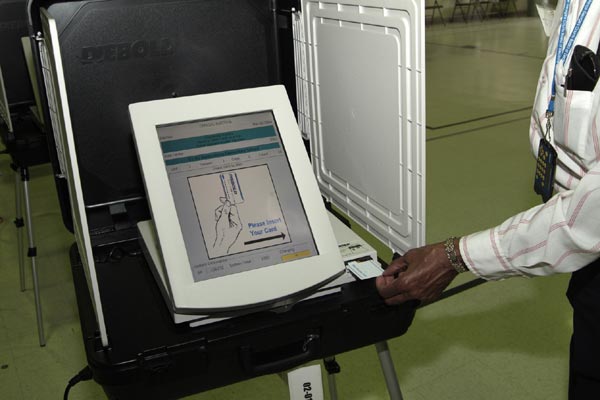
Sample direct recording electronic (DRE) voting machine
Following the infamous hanging-chad fiasco in Florida during the 2000 U.S. presidential election, the federal Help America Vote Act of 2002 aimed to modernize election systems in the United States, in part by encouraging states to transition from paper ballots to electronic voting systems. That 2000 reform, however, may have led to the unintended consequence of making U.S. elections more vulnerable to hacking. Amid reports of cyberattacks against voting systems in Florida, Georgia, and other states in the recent 2018 election, officials are questioning the efficacy of machine-based or electronic voting that lacks a paper trail. Many experts have called for a return to paper ballots or at least paper-records that can be used to audit machine-voting tallies. As election security expert and Georgetown Law Center Professor Matt Blaze said, "'It's ironic that the famous picture of an election official examining a paper ballot during the Florida recount' was used to illustrate the primitivism of punch-card voting machines, but now is used to demonstrate the robustness of paper ballots."
Paperless voting systems continue to be popular, however. During the 2018 election cycle, most states relied on Direct Recording Electronic (DRE) voting systems, which store votes directly into a computer’s memory. The National Conference of State Legislatures notes that DRE systems can be equipped to provide a “voter-verifiable paper audit trail” (VVPAT) that serves two functions. First, VVPAT capabilities allow voters to verify that their ballots are recorded correctly. Second, VVPAT systems provide a paper trail for election officials should an audit become necessary. Nonetheless, ABC reported that 5 states (Louisiana, Georgia, South Carolina, New Jersey, and Delaware) used versions of Direct Recording Electronic (DRE) systems that leave no paper record of individual votes. Additionally, ABC notes that 8 states, including Pennsylvania, use DRE systems without a paper trail in at least one, but not all, counties.
Experts are increasingly critical of paperless DRE systems. A 2018 report "Securing the Vote: Protecting American Democracy" by the National Academy of Science calls for such systems to be “removed from service as soon as possible.” The Brennan Center argues that $380 million in federal funding recently authorized for election modernization is nowhere near enough to address the potential scope of interference in the 2020 election. Specifically, experts warn that paperless DRE systems tend to be older systems, most vulnerable to hacking. A New Yorker piece illustrates the grave risk, recounting a 2018 hacking conference in which hackers were able to infiltrate each of 24 voting machines on display, “some within minutes." Nonetheless, some state officials insist that paperless DRE systems are safe. For example, Delaware Election Commissioner Elaine Manlove told ABC news that DRE machines are not connected to the internet and are not connected to other machines. Thus, hackers would have to penetrate each individual machine to change vote tallies.
State responses have been mixed. The Brennan Center surveyed election officials in jurisdictions that use paperless DRE systems and received a wide variety of responses. Six states have taken direct action to replace all paperless machines with DRE systems equipped with VVPAT systems. These include the 5 states entirely reliant on paperless DRE systems and Pennsylvania. Other jurisdictions have taken a more measured response. Kentucky election officials, for example, have called for the replacement of paperless DRE systems but have yet to secure the funding to do so. Kansas has prohibited counties from purchasing new paperless DRE systems, but has not banned the use of existing paperless machines. Still other jurisdictions have taken no apparent action to replace paperless machines, including Indiana, Mississippi, Tennessee, and Texas. In fact, one municipal election official in Texas reported to the Brennan Center that he hoped to replace existing paperless machines with a new set of paperless machines.
Jurisdictions that are taking action to replace paperless DRE systems are turning to a number of different alternatives. The Brennan Center report estimates that 55% of counties that intend to replace paperless DRE systems hope to purchase optical scanning machines, which rely on computers to scan and tally paper ballots. While optical scanning systems are still vulnerable to hacking of final tallies, they allow officials to retain paper ballots for auditing purposes. An additional 13% of counties intend to purchase DRE systems that are equipped with VVPAT technology, allowing officials to collect a paper trail of each individual vote. 6% of counties report plans to purchase ballot marking devices, which require voters to input their choices on a computer that in turn marks a paper ballot rather than storing votes to internal memory. The remaining 26% of counties have not specified an alternative voting system they intend to purchase.
The decentralized nature of American elections is often touted as an asset. Because elections are typically administered at the county level, hackers have to effectively infiltrate thousands of individual election systems rather than one centralized system. Given both the vulnerability of dated DRE systems and the demonstrated commitment of foreign actors to influence American elections, many believe that a federal mandate to collect paper records of individual votes could help strengthen the American electoral system.